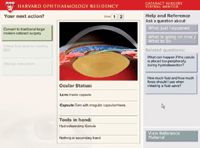Article
Virtual simulator being developed as training tool
An interactive computer-based surgical teaching program is being developed as a training tool to provide users with the cognitive aspects of learning that are fundamental for developing expertise.
Boston-An interactive computer-based surgical teaching program (Virtual Mentor) is being developed as a unique training tool to provide users with the cognitive aspects of learning that are fundamental for developing expertise and achieving good outcomes, said Bonnie A. Henderson, MD.
Dr. Henderson is a partner at Ophthalmic Consultants of Boston, and she is assistant clinical professor of ophthalmology, Harvard Medical School. She is developing this program in collaboration with John Loewenstein, MD, with grant support predominantly from the Department of Defense.

"[The program] is being designed as an interactive tool to engage users and take them through these mental exercises," Dr. Henderson added.
A first program is being written for phacoemulsification and is expected to be completed by August 2010. It simulates all of the steps in the procedure and provides training about potential errors and performing surgery in complicated situations.
For example, the user can select to "perform" a procedure in an eye in which capsulorhexis creation becomes complicated by a radial tear. The program instructs users on why such a problem occurs so that they know how to avoid it, as well as how to resolve the situation and the rationale for the corrective action.
A prototype of the program was finished several years ago and evaluated in a prospective, multicenter, randomized, masked trial that generated encouraging results, she said.
In that study, users were randomly assigned to learning hydrodissection using the computer program or traditional teaching tools.
Comparing teaching value
The educational value of the two techniques was compared by administering pre- and post-multiple choice tests and questionnaires to determine changes in knowledge.
Results showed that the group using the computer program had a significantly greater gain versus the controls.
User acceptance of the program also was much higher based on responses to questions probing user impressions about their experience.
"The participants in our study really enjoyed using the [computer program] much more than traditional tools, and their responses indicated they would be much more likely to use it again," she said.
"No matter how fantastic a teaching tool seems, unless it is used, it will not be effective," she added.
Although the interactive program aims to provide surgical training to residents as well as to ophthalmologists in practice who are interested in learning new techniques, it is the younger generation of physicians who particularly connect with this type of technology, since they are accustomed to getting information electronically rather than by depending on print material, according to Dr. Henderson.
A complete package
Dr. Henderson and Dr. Lowenstein also foresee that the virtual simulator might be integrated with a physical surgical simulator so that a user can physically "perform" a procedure and simultaneously benefit from cognitive feedback.
They are currently in discussions with one manufacturer (EYESI VRMagic) on going forward with this project.
"Each group is continuing to work independently to develop our own technology, but we have also been collaborating on bringing the two portions together," Dr. Henderson said. "[We hope] we will be able to find a platform so that the two technologies can work together seamlessly."
Newsletter
Don’t miss out—get Ophthalmology Times updates on the latest clinical advancements and expert interviews, straight to your inbox.





